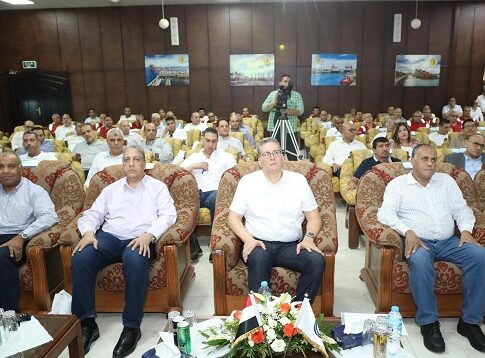The inspection tour of Eng. Karim Badawi, Minister of Petroleum and Mineral Resources, in the Eastern Desert fields witnessed the holding of a workshop for a number of production companies in the region (Gulf of Suez Petroleum Company (GUPCO), Belayim Petroleum Company (Petrobel), PetroGulf Egypt, Suez Oil Company (SUCO), and Shuqair Marine Oil Company (USOCO), during which the production and development plans implemented by the five companies were presented.
Badawi stressed that commitment to safe operation, maintaining the environmental friendliness of our industry, and continuously developing and supporting this are essential elements for achieving sustainability and creating an attractive environment for more investments to support growth and development plans, including plans to provide the needs of the local market, stressing his personal support for ideas, innovations, applicable solutions, digital transformation, and the continuous addition of modern technologies to support plans and efforts to increase production, as everyone is a participant and responsible. He sent a message to the workers that the Ministry, the Petroleum Authority, and the holding companies are open to receiving and discussing all suggestions that contribute to growth and increasing production rates.
GUPCO: Exploration and Production Activity A Breakthrough in Asset Safety Program Implementation
Eng. Salah Abdel Karim, Chairman of GUPCO, reviewed the company’s achievements in the field of safety, increased production and asset safety, pointing out the drilling of 5 new wells in the North Safa exploration area, as well as the drilling of two new exploratory wells based on the results of the new seismic survey of its areas, and its plan to replace gas compressors designated for artificial oil lifting with investments of about $80 million, and its achievement of a major leap in terms of asset safety by replacing old production lines with investments of about $110 million. He also explained the position of qualifying and training workers and the progress achieved in implementing digital transformation, the SAP system, digitizing performance and introducing artificial intelligence to improve productivity.
“Petrobel” Unconventional solutions to develop Sinai fields and face challenges
Eng. Khaled Mowafy, Chairman of Petrobel, explained that the company has 14 opportunities available for exploration with a total reserve of 55 million barrels and a plan to drill two exploration wells in the South Feiran area with a reserve estimated at 4 million barrels and the A-8 area with a reserve of 4 million barrels and a production rate of up to 2,000 barrels per day. He added that due to the obsolescence of the oil fields in Sinai (more than 70 years), there had to be unconventional solutions for development, so attention turned to developing unconventional reservoirs in production with protrusions with a remaining reserve estimated at about 10.5 million barrels. He explained Petrobel’s plan to overcome the challenges, including the complex geological structures in the Gulf of Suez and the total production of 91% of the declared reserve and the lack of surface areas on offshore platforms to drill new wells due to the crowding of platforms and the obsolescence of surface facilities and treatment plants. Therefore, modern engineering studies are being conducted to continue using these assets in addition to working to increase drilling operations.
“SUCO” We integrate our facilities with companies in the region and develop new layers
Eng. Mohamed El Khayat, Chairman of SOCO, reviewed the challenges faced and the company’s continuous search for optimal utilization of available resources, and its provision of facilities to sister companies, which in turn benefited both sides and consequently led to a decrease in the cost of producing a barrel despite the severe decrease in production rates. He added that an ambitious work plan was prepared with two main axes, the first is short-term, aims to double the company’s production during the second quarter of the current fiscal year by implementing a well repair plan to return them to production again, as well as development drilling, while the second axis aims to exploit all opportunities outside the current development area, which includes, for example, the southwestern region of the Ras Badran field, which is expected to increase reserves by about 172 million barrels of oil, as well as the Matla layer, which is not fully developed in the field.
“PetroGulf Egypt” Geisum field is an important shift and we are continuing to work on increasing production
Eng. Abdel Wahab El Maghawry, Chairman of PetroGulf Egypt, explained that through exploration and development activities, the company was able to add 13.2 million barrels to its oil reserves, bringing the total remaining reserves to 85 million barrels. It also plans to achieve zero flaring of flare gas by replacing diesel-powered generators with gas-powered ones.
He explained the role of the discovery of the North Geisum field as a turning point in its history, and the challenges it faced, such as building an offshore platform in record time and drilling many deep directional wells at highly deviated angles, which jumped production to exceed 20,000 barrels of oil per day, after it was about 4,000 barrels of oil per day.
“OSOCO” Increase production over the next three financial years
Eng. Walid Al-Asar, Chairman of OSOCO, said that it has a reserve of about 49 million barrels of equivalent in its six production areas that it started operating in since 1980, and that it has a plan to drill 4 exploratory wells through which it works to increase reserves and production, noting that its current average production is 5,700 barrels per day, which is being increased during the current fiscal year by drilling about 9 wells between exploratory, developmental and repair. He also presented an expected production plan to reach production of 8,500 barrels per day by the end of fiscal year 2026/2027.

